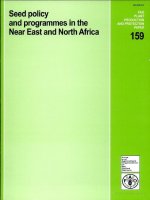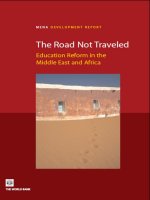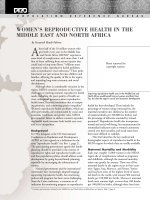Explore travel guides colombia bogotá and north coast
Bạn đang xem bản rút gọn của tài liệu. Xem và tải ngay bản đầy đủ của tài liệu tại đây (4.51 MB, 329 trang )
Please review this travel guide on
www.amazon.com
Submit additional suggestions or comments to
Businesses in Colombia are constantly evolving, please send us any new
information on prices, closures and any other changes to help us
update our information in a timely manner.
Written and researched by
Justin Cohen
Copyright ©2013 by Explore Travel Guides Colombia
ISBN – 978-958-44-8071-2
Map and book design by
Blackline Publicidad EU
Bogotá, Colombia
This travel guide is licensed under a Creative Commons
Attribution-NonCommercial-NoDerivs 3.0 Unported License.
You are free: to share, to copy, distribute and transmit this work.
Distributed by Explore Travel Guides Colombia
www.gotocolombia.com
CONTENTS
General Information ............................................................................. 17
Colombia Websites for Travelers .............................................................. 48
Activities in Colombia ............................................................................. 59
A Brief History of Colombia ..................................................................... 64
Bogotá .................................................................................................. 89
Outside of Bogotá ................................................................................ 153
Suesca............................................................................................. 153
Guatavita ........................................................................................ 154
Parque Natural Chicaque ................................................................. 157
North Coast ......................................................................................... 159
Cartagena ....................................................................................... 161
Tolú ................................................................................................. 194
Santa Cruz De Mompox ................................................................... 201
Barranquilla .................................................................................... 207
Santa Marta ..................................................................................... 222
El Rodadero..................................................................................... 239
Minca.............................................................................................. 244
Parque Tayrona ............................................................................... 250
Taganga........................................................................................... 257
Outside of Santa Marta .................................................................. 275
Riohacha ......................................................................................... 278
Cabo De La Vela ............................................................................... 288
Valledupar....................................................................................... 291
Other Popular Destinations in Colombia ............................................. 305
Motorcycling....................................................................................... 312
English – Spanish Dictionary ............................................................... 317
GENERAL INFORMATION 17
GENERAL INFORMATION
This book is intended to be a resource to help plan your lodging, activity,
restaurant, nightlife and transportation choices while visiting Bogotá and the
North Coast of Colombia.
PRICES
The prices have been broken down into three categories for both
accommodations and restaurants. All prices used in this book are in Colombian
pesos (COP).
Accommodations
Budget = Under 30,000 COP per night
Mid-Range = Between 30,001 COP and 80,000 COP per night
Expensive = More than 80,001 COP per night
Restaurants
Budget = Under 15,000 COP for a meal and a drink
Mid-Range = Between 15,001 COP and 25,000 COP for a meal/drink
Expensive = Over 25,001 COP for a meal and drink
18 GENERAL INFORMATION
CLIMATE
There are climate charts in Celsius and Fahrenheit throughout the book for
larger cities that have airport weather reporting systems. The weather in
Colombia varies according to each region.
Although Bogotá is almost always cold and rainy, the sun does show itself,
especially from mid-December through January. It's recommended to pack a rain
coat, sweatshirt and other mountain weather clothing. People respond to
weather differently. If you don't react well to cold weather, its best to bring
gloves and a warm hat.
The North Coast's climate is extremely hot. It's recommended to pack clothing
that you can breathe in. It rains on the coast all year, but especially in September
and October. August and November also see frequent rainfall. The rain will come
and go, but the rainy season can have an effect on people's vacation times. If
you're looking for a pure beach experience, it's best to plan your time on the
coast in a careful manner.
Medellín and Bucaramanga have the most pleasant climates. Medellín has even
earned the nickname "the City of Eternal Spring". If you're looking for
prototypical perfect weather these two locations are recommended.
The Coffee Region is pleasant, but it has mountain-like weather conditions. Its
best to come prepared when visiting these areas.
Cali has hot weather, but not as hot as the coast.
GENERAL INFORMATION 19
CLOTHES
Packing for Colombia is not an easy task. With the drastically different climates a
person must choose their clothing choices wisely. It's highly recommended that
you bring the following items for your stay.
All of Colombia
Raincoat and pants
A pair of pants
Long sleeve shirt with collar (men)
Broken in hiking boots or reliable shoes to walk in
For men with large feet, an extra pair of shoes, as they can be hard to find
For Bogotá (depending on your cold tolerance)
Hat
Gloves
Heavy sweatshirt or sweater
For the North Coast
Bathing suit
Sandals or flip-flops
Light weather clothing
For Nights on the Town
When you go out you will want to look nice. Colombians are excellent dressers
and fashion is important. For men a collared shirt and pants are essential. Most
places you can wear jeans, but if you're going to a club, a nice outfit from head
to toe is recommended. Women can adhere to their own style, but making an
effort is essential. You should expect more attention from people based on the
fact that you're a foreigner. Like most places in the world the way you dress has
a huge impact on your first impression.
20 GENERAL INFORMATION
Buying Clothing
You can find all the clothing that you forgot to bring with you anywhere in
Colombia. Some items may be more expensive, but if you take your time you can
find what you need at reasonable prices.
Laundry
It's also best to remember the length of your trip and your laundry
requirements. Most hostels or hotels have a service to do laundry. It can be
costly in certain parts of the country. You must think of your clothes situation
deeply as having the proper clean clothing takes effort and planning.
FOOD
Eating in Colombia is an experience in itself. On the coast, fish-based meals are
common and easy to find. Colombian meals are large and usually include soup, a
meat dish, and a few sides. They are usually more on the un-healthy side.
Vegetarian restaurants can be found, but they are not common. If you take the
time, you can find acceptable meals by dining in restaurants, on the street and
purchasing food from grocery stores.
Restaurants
Different types of food can be found all over Colombia. International menus are
common alongside Colombian food. Chicken, meat and fish are the core items
on the menu.
Streets
Cheap meals can be found on all Colombian streets. Fast food such as hotdogs,
hamburgers, pizza and other common junk food are available in all cities.
Colombian hand-held snacks such as arepas and empanadas can be found all
over the country. It's HIGHLY recommended NOT to eat from street vendors
unless you've been traveling in Latin America for an extended period of time.
Your body needs to adjust and eating vendor food is the fastest way to ruin your
GENERAL INFORMATION 21
vacation. Even seasoned travelers get sick when eating off the street. Please be
careful.
Grocery Stores
There are major chains of grocery stores in big and mid-sized cities. You can find
a great variety of products that allows you to cook at your hostel and put
together meals with different items. Many backpackers in Colombia save money
by cooking their favorite meals in their hostel.
Fruit
Colombia is a fruit lovers paradise. Smoothies and fruit drinks are very popular.
You can find fruits in restaurants, stores and in the street.
Vegetables
Vegetables can be found all over Colombia, but not with the same variety as
fruit. It's hard to find a good salad, but it is possible. Vegetable lovers need to
make an effort to get their daily intake, but it's not an impossible task. One
should be careful about how well-washed the vegetables are before ordering
salad - cooked vegetables are more reliable.
EMBASSIES AND CONSULATES
Embassies are located in Bogotá and many countries maintain consulates
throughout Colombia in other major cities. Please consult the following website
below for your home country. Please check if the information is correct before
coming to Colombia. It's important to understand your country's level of
assistance if you run into a problem. Most embassies encourage you to register
upon arrival in a foreign country. (www.embassiesabroad.com/embassiesin/Colombia).
22 GENERAL INFORMATION
DOCUMENTS
All foreign travelers must have a valid passport to enter Colombia. It's the
traveler's responsibility to make sure their passport is current and has at least six
months of validity. There must be blank pages to stamp upon arrival. It's highly
recommended that travelers make multiple photo copies of their main
passport page and the page with their entrance stamp. While in Colombia, law
enforcement officers and soldiers have the right to ask for identification without
probable cause. A photo copy of your passport can be presented. Your passport
along with your ATM and credit cards are your most important possessions. It's
critical to be aware of your passport's location at all times. By carrying a copy of
your passport you lessen the risk of losing it or having it stolen. The last thing
you want to do is spend your precious vacation days at the embassy dealing with
a replacement.
If you wish to drive you must have a valid driver's license. Driver licenses are
recognized from foreign countries. If you want to ride a motorcycle you must
have a valid motorcycle designation on your driver's license.
VISAS
Below is a list of countries that are eligible for basic tourist visas. This list is
subject to change and it's the traveler's responsibility to verify their personal
requirements based on their home country.
Andorra, Antigua & Barbuda, Argentina, Australia, Austria, Bahamas, Barbados,
Belgium, Belize, Bolivia, Brazil, Brunei-Darussalam, Canada, Chile, Costa Rica,
Croatia, Cyprus, Czech Republic, Denmark, Dominica, Dominican Republic,
Ecuador, El Salvador, Estonia, Finland, France, Germany, Greece, Grenada,
Guatemala, Guyana, Holland, Honduras, Iceland, Indonesia, Ireland, Israel, Italy,
Jamaica, Japan, Korea (Rep), Liechtenstein, Lithuania, Luxembourg, Malaysia,
Malta, Mexico, Monaco, Norway, New Zealand, Northern Ireland, Panama,
GENERAL INFORMATION 23
Paraguay, Peru, The Philippines, Poland, Portugal, Romania, San Marino, Slovak
Republic, South Africa, Spain, St. Kitts & Nevis, St. Lucia, St Vincent & the
Grenadines, Singapore, Sweden, Switzerland, Taiwan, Trinidad & Tobago, Turkey,
UK, Uruguay, USA, Venezuela.
Citizens from the above list can travel within Colombia for a period of six
months.
Citizens from other countries must inquire with the Colombian government for
their visa requirement.
Upon arrival in Colombia tourists will receive either a 30, 60, or 90 day tourist
stamp. It's critical that you get a stamp for the total length of your trip. Ask the
agent for the longest length possible (90 days). If you're given a 30 day stamp
and plan on being in Colombia for 40 days you will have a legal problem. It is
critical that you clarify your length of stay before the agent stamps your
passport. By law you need an ongoing ticket to another country. This is not
always asked for, but you need to be ready to prove that you will be leaving
Colombia. If you plan on staying in Colombia past your original visa expiration
you must visit the Departamento Administrativo de Seguridad (DAS). You can
receive 30-day extensions up to the maximum of a six month total stay in
Colombia. There is a process to learn this extension. You must present yourself
to DAS to receive the current requirements. A representative of DAS will give
you instructions that will most likely consist of possessing a valid passport,
having your fingerprints taken, taking a trip to the bank, and providing photos,
as well as other safeguards. In big cities, it's best to plan a good part of your day
to do this. It's highly recommended you visit the DAS offices in smaller cities as
they provide quicker service because they see less foreign visitors. It's
impossible to list the exact requirements as they can change and are also
interpreted differently in different DAS offices.
24 GENERAL INFORMATION
Explore Travel Guides Colombia insists that ALL travelers research their own
personal situation for their visa requirements. The above information is
subject to change and it's critical all travelers understand their visa situation
before arriving in Colombia.
MONEY
Colombian Peso
The currency in Colombia is the Colombian peso. The value of the Colombian
peso is liable to fluctuate on a daily basis. From Jan. to Mar. 2013, the peso
fluctuated between 1,758 - 1,818 COP per dollar.
The peso is referred to as COP, in this travel guide.
The COP is found in 100, 200 and 500 coins and in 1,000, 2,000, 5,000, 10,000,
20,000 and 50,000 paper notes. It's convenient to carry coins to pay for things
on the street. It's critical to have an understanding of Colombian money upon
arrival.
20,000 and 50,000 notes are very difficult to change in many places. A smart
traveler will hoard smaller notes and change the larger bills at grocery stores,
gas stations, higher-end restaurants, chain restaurants and establishments that
see higher levels of business. Small stores, taxis and people on the street have a
hard time changing the larger notes.
Counterfeit money floats around Colombia and you will notice that most
cashiers and vendors check the notes. It's difficult to give a lesson in a travel
guide on how to spot these bad bills. The best practice is to check your bills
when they come out of the ATM. If they look funny ask a trusted Colombian to
take a look at the note. If it's bad, you need to make a trip to the bank or accept
that you have a new souvenir with a story. Don't pay your taxi with a 20,000
COP or 50,000 COP note. It's best to have exact change for taxis. There is a
common taxi scam in which the driver switches your original note with a
GENERAL INFORMATION 25
counterfeit and returns it to you telling you he can't accept it. Two travelers have
reported this scam during the writing of this book.
Exchanging Money
You can exchange money at the airport, but the rate of exchange is not favorable
for travelers. In major cities there are money exchange businesses that give
better rates. In Bogotá you can exchange money at the mall at Parque 93 and
the mall at Usaquén. There are multiple money exchange businesses. If you're in
Colombia on business and are dealing with large money exchange transactions
you need to take precautions. The Colombian National Police will assist with
security escorts for money exchanges to a safe point, upon request from
foreigners.
It's recommended to use ATMs to receive your money in Colombia.
ATMs/ Credit Cards
Colombia has a modern and extensive banking system. There are dozens of
banks and you can find ATMs everywhere. Upon arriving at the airport you can
find multiple ATMs to receive your original traveling money. ATMs in Colombia
accept the same network of ATM cards throughout the world. Still, some
travelers have reported problems with using their ATM in Colombia. This is rare,
but it happens. It's best to carry an extra ATM card to protect from this
happening.
Travelers MUST inform their bank that they will be using their card in Colombia
and other countries where they're traveling. Many banks will shut off access to
cards that are being used abroad. A simple phone call to the bank before your
travels can help avoid this. Banks do this to protect their customers from fraud.
You should also check your bank's transaction fee for international withdrawals.
Many banks have varying rates for the transaction.









